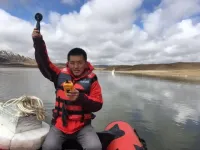(Press-News.org) An amber fossil of a Cretaceous beetle has shed some light on the diet of one of the earliest pollinators of flowering plants.
The animal's remains were unearthed by researchers at the University of Bristol and the Nanjing Institute of Geology and Palaeontology of the Chinese Academy of Sciences (NIGPAS) who were able to study its fossil faecal matter, which was composed solely of pollen.
Besides being a visitor of angiosperms - flowering plants - researchers now have conclusive evidence that the new fossil named Pelretes vivificus also fed on their pollen. Details of this discovery have been published today in Nature Plants.
"The beetle is associated with clusters of pollen grains, suggesting that short-winged flower beetles visited angiosperms in the Cretaceous. Some aspects of the beetle's anatomy, such as its hairy abdomen, are also adaptations associated with pollination," said Professor Chenyang Cai, palaeontologist from the School of Earth Sciences and NIGPAS.
Erik Tihelka, entomologist and palaeontologist at the School of Earth Sciences, added: "The fossil is associated with beetle coprolites - fossil faecal pellets - that provide a very unusual but important insight into the diet of short-winged flower beetles in the Cretaceous. The fossil faecal pellets are completely composed of pollen, the same type that is found in clusters surrounding the beetle and attached to its body. We thus know that Pelretes visited angiosperms to feed on their pollen. This finding provides a direct link between early flowering plants in the Cretaceous and their insect visitors; it shows that these insect fossils were not just incidentally co-preserved with pollen, but that there was a genuine biological association between the two."
While pollinators such as bees and butterflies provide crucial ecosystem services today, little is known about the origin of the intimate association between flowering plants and insects.
Cretaceous amber fossils provide an important source of evidence for understanding the biology of early angiosperms, before they became the dominant group of plants on Earth. Amber is the fossil resin of ancient trees that often fortuitously trapped insects and other small organisms, preserving them with life-like fidelity.
"Farmers who want to protect their orchards can set up sticky traps on trees to monitor insects. Now imagine if your only insight into an ancient ecosystem were such sticky traps and you were to reconstruct all its ecological interactions based solely on this source of evidence. That is the challenge faced by palaeontologists studying amber," explains Tihelka. "Luckily, the amber trap from northern Myanmar is one of the riches fossiliferous amber deposits known. Besides the unparalleled abundance of fossil insects, the amber dates back to the mid-Cretaceous, right when angiosperms were taking off," said Mr Tihelka.
Two hundred million years ago the world was as green as today, overgrown with dense vegetation. But it was not as colourful - there were no flowers. Flowering plants that make up over 80% of all plant species today, only begun to diversify in the Cretaceous, about 125 million years ago. Some scientists have attributed the huge evolutionary success of angiosperms to their mutualistic relationships with insect pollinators, but fossil evidence of Cretaceous pollinators has so far been scarce.
The flower beetle Pelretes vivificus lived in the Burmese amber rainforest some 98 million years ago. Its closest relatives are short-winged flower beetles (Kateretidae) that today occur in Australia, visiting a diverse range of flowers and feeding on their pollen.
"The pollen associated with the beetle can be assigned to the fossil genus Tricolpopollenites. This group is attributed to the eudicots, a living group of angiosperms, that includes the orders Malpighiales and Ericales," explains Dr. Liqin Li, fossil pollen specialist from NIGPAS who contributed to the study.
This shows that pollinators took advantage of early angiosperms soon after their initial diversification and by the mid-Cretaceous visited a diverse range of groups.
INFORMATION:
Paper:
"Angiosperm pollinivory in a Cretaceous beetle" by Erik Tihelka, Liqin Li, Yanzhe Fu, Yitong Su, Diying Huang and Chenyang Cai, published in Nature Plants.
Researchers from the National Institutes of Health have identified and tested a drug combination that exploits a weakness in small cell lung cancer (SCLC), an aggressive, dangerous cancer. The scientists targeted a vulnerability in how the cancer cells reproduce, increasing already high levels of replication stress ¬¬-- a hallmark of out-of-control cell growth in many cancers that can damage DNA and force cancer cells to constantly work to repair themselves. In a small clinical trial, the drug duo shrank the tumors of SCLC patients. The team reported its findings April 12 in Cancer Cell.
While many patients with small cell lung cancer initially respond to chemotherapy, they lack an effective follow-up treatment. These patients usually live a matter of weeks after their ...
A new test that measures the quantity and quality of inactive HIV viruses in the genes of people living with HIV may eventually give researchers a better idea of what drugs work best at curing the disease.
Currently no cure exists for HIV and AIDS, but antiretroviral therapy drugs, or ARTs, effectively suppress the virus to undetectable levels.
Published today in Cell Reports Medicine, the study discusses how a new test, developed jointly by scientists at the University of Washington School of Medicine and Fred Hutchinson Cancer Research Center, will ...
While pollinators such as bees and butterflies provide crucial ecosystem services today, little is known about the origin of the intimate association between flowering plants and insects.
Now, a new amber fossil unearthed by researchers from the Nanjing Institute of Geology and Palaeontology of the Chinese Academy of Sciences (NIGPAS) and the University of Bristol sheds light on some of the earliest pollinators of flowering plants.
The study was published in Nature Plants on April 12.
Two hundred million years ago the world was as green as today, overgrown with dense vegetation, but it was not as colorful. Flowering plants (angiosperms) that make up over 80% of all plant species today, only began to diversify in the Cretaceous, about 125 million years ago.
Some scientists have attributed ...
A new 160-million-year-old arboreal pterosaur species, dubbed 'Monkeydactyl', has the oldest true opposed thumb - a novel structure previously not known in pterosaurs.
An international team of researchers from China, Brazil, UK, Denmark and Japan have described a new Jurassic pterosaur Kunpengopterus antipollicatus, which was discovered in the Tiaojishan Formation of Liaoning, China.
It is a small-bodied darwinopteran pterosaur, with an estimated wingspan of 85 cm. Most importantly, the specimen was preserved with an opposed pollex ("thumb") on both hands.
The species name 'antipollicatus' ...
Singapore, 12 April 2021 - Researchers from the Low Energy Electronic Systems (LEES) Interdisciplinary Research Group (IRG) at Singapore-MIT Alliance for Research and Technology (SMART), MIT's research enterprise in Singapore, together with Massachusetts Institute of Technology (MIT) and National University of Singapore (NUS) have found a method to quantify the distribution of compositional fluctuations in the indium gallium nitride (InGaN) quantum wells (QWs) at different indium concentrations.
InGaN light emitting diodes (LEDs) have revolutionised the field ...
A new study conducted jointly by the Univerisyt of Liege (Belgium) and the University of Reading (England) suggests that 34% of the Antarctic ice shelves could disappear by the end of the century if the planet warms up by 4°C compared with pre-industrial temperatures. This melting could lead to a significant rise in sea levels. This study is published in the journal Geophysical Research Letters.
Since the early 2000s, scientists have observed that the Antarctic ice sheet is losing mass at a rate that is accelerating. The ice sheet is a very thick expanse of ice that can cover an entire continent. There are only two ice sheets on Earth: the Greenland ice sheet, which is limited to the ...
A shared set of systems in the brain may play an important role in controlling the retrieval of facts and personal memories utilised in everyday life, new research shows.
Scientists from the University of York say their findings may have relevance to memory disorders, including dementia, where problems remembering relevant information can impact on the daily life of patients.
Researchers say the findings may also have important implications for the development of a new generation of artificial intelligence systems, which use long-term memory in solving computational problems.
The brain's long-term memory stores are categorised into two: factual memory ...
Researchers at the University of Toronto have found that a calorie labelled is not the same as a calorie digested and absorbed, when the food source is almonds.
The findings should help alleviate concerns that almonds contribute to weight gain, which persist despite the widely recognized benefits of nuts as a plant-based source of protein, vitamins and minerals.
"Nuts have generally been thought of as healthy the last two decades, but the messaging around nuts has often come with a disclaimer that they are high in fat and energy," said John Sievenpiper, ...
Inland waters are an important component of the global carbon cycle and function as active reactors, transporting and transforming large quantities of naturally- and anthropogenically-derived carbon. Previous studies suggest that inland waters are major sources for greenhouse gas emissions to the atmosphere, yet these emissions are poorly constrained (Note 1).
As a primary greenhouse gas that drives global climate change, carbon dioxide (CO2) emissions from inland waters play a key role in assessing global carbon cycle. While most efforts over the last decade have focused on refining the emission flux estimates at the regional and global scales, scientists do not fully understand the responsiveness of regional ...
A recent study finds U.S. companies that have a substantial number of employees in foreign jurisdictions with lower tax rates are more likely than their peers to "artificially" locate earnings in those jurisdictions - and the Internal Revenue Service (IRS) is less likely to challenge these complex tax-planning activities.
"Many politicians seek to encourage domestic employment and discourage sending jobs overseas," says Nathan Goldman, co-author of the study and an assistant professor of accounting in North Carolina State University's Poole College of Management. "To do that, they'll need to address elements of corporate tax policy that effectively encourage ...




